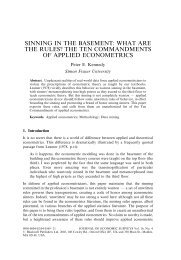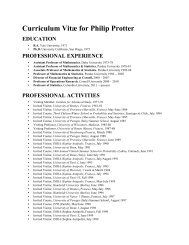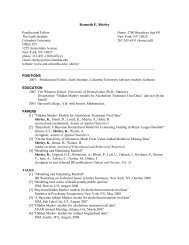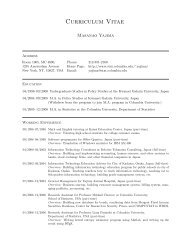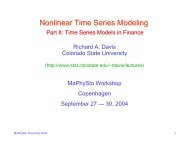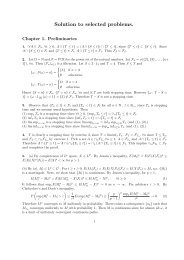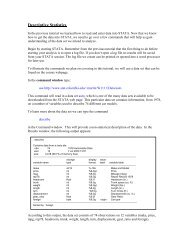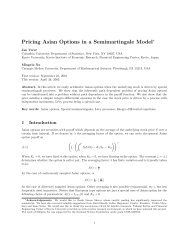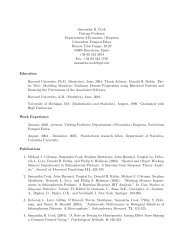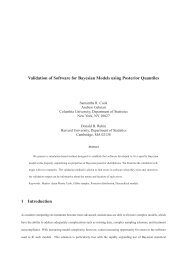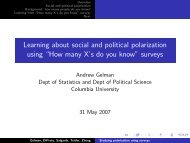The Self-Controlled Case Series - Department of Statistics ...
The Self-Controlled Case Series - Department of Statistics ...
The Self-Controlled Case Series - Department of Statistics ...
Create successful ePaper yourself
Turn your PDF publications into a flip-book with our unique Google optimized e-Paper software.
<strong>Self</strong>-<strong>Controlled</strong> <strong>Case</strong> <strong>Series</strong> 11<br />
For notational simplicity, we consider point exposures followed by some<br />
known increased-risk time. <strong>The</strong> exposures then partition the observation<br />
period into up to five periods indexed by j: a control period, followed by<br />
an increased-risk period, followed by a control period, followed by a second<br />
increased-risk period, followed by a final control period. Denote by n ij the<br />
number <strong>of</strong> events occurring in the jth period, n ij ∈ {0, 1}. Let β 1 and β 2 denote<br />
the log relative incidences associated with the first and second increased<br />
risk periods respectively and denote by T i the event time.<br />
If T i occurs after c i2 then no further exposures can occur and inference<br />
about β 2 can proceed in the usual fashion. Inference for β 1 is more complex<br />
in the situation where the event occurs after just one exposure becuase the<br />
timing <strong>of</strong> the counterfactual second exposure is then unavailable. Farrington<br />
et al. then make the following key observation: suppose, counterfactually,<br />
that no individual experienced a second exposure. <strong>The</strong>n it would be possible<br />
to estimate β 1 without bias. For this to work, we would need to know n ∗ i4 ,<br />
the number <strong>of</strong> events in the fourth period, had no second exposure occurred.<br />
This is missing for those individuals that did in fact have a second exposure.<br />
However, n i4 e −β2 is an unbiased estimate <strong>of</strong> n ∗ i4 for these individuals - this<br />
amounts to backing out the actual elevated risk during the second exposure.<br />
Using n ∗ i4 in place <strong>of</strong> n i4 then leads to an unbiased estimate <strong>of</strong> β 1 .<br />
Farrington et al. present the general case, an associated sandwich estimator<br />
for the variance, and also a computationally efficient equivalent approach<br />
based on pseudo likelihood.<br />
We note that Roy et al. (2006) present an alternative approach.<br />
4.4. Structured SCCS Models<br />
. We are currently exploring several extensions to the basic model.<br />
(i) Hierarchical model: Drugs. Drugs form drug classes. For example,<br />
Vioxx is a Cox-2 inhibitor. Cox-2 inhibitors in turn are non-steroidal<br />
anti-inflammatories. A natural extension assumes regression coefficients<br />
for drugs from within a single class arise exchangeably from a common<br />
prior distribution. This hierarchy could extend to multiple levels.<br />
(ii) Hierarchical model: AEs. AEs also form AE classes. For example, an<br />
MI is a cardiovascular thrombotic (CVT) event, a class that includes, for<br />
example, ischemic stroke and unstable angina. In turn, CVT events belong<br />
to a broader class <strong>of</strong> cardiovascular events. This extension assumes<br />
that the regression coefficients for a particular drug but for different<br />
AEs within a class arise from a common prior distribution. Again this<br />
hierarchy could extend to multiple levels.



